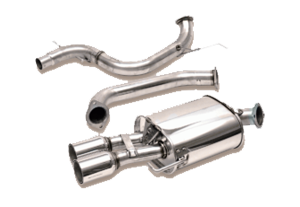Catalytic Converter Replacement
Because of the role they play in passenger safety and emission control, catalytic converters are important exhaust system components. Without a catalytic converter, your exhaust system would release poisonous and dangerous gases, like carbon monoxide, hydrocarbons, and nitrogen oxide. A damaged catalytic converter must be replaced at the first sign of trouble. Clogged catalytic converters are also dangerous. If you try to accelerate but your vehicle fails to speed up, the catalytic converter may be clogged, which will quickly cause your engine to fail. The smell of sulfur also indicates a bad catalytic converter. A damaged oxygen sensor can lead to the catalytic converter operating less efficiently and reducing its lifespan. If there is not enough oxygen, the harmful gases will fail to diminish, while too much oxygen can cause the converter to overheat and fail. Our service staff will conduct tests to determine the exact cause of a malfunctioning catalytic converter.
Center Exhaust Section Replacement
A center exhaust system may need to be replaced for a few reasons. The catalytic converter may be failing. Pipes may be corroded or clogged. Because the catalytic converter is tasked with converting the harmful emissions of carbon monoxide, hydrocarbons, and nitrogen oxide into less harmful elements like oxygen, nitrogen, water vapor, and carbon dioxide, a clogged catalytic converter may mean that these harmful and deadly gases are being released into the cabin of your vehicle. A clogged catalytic converter will result in a loss of vehicle acceleration, low gas mileage, and stalling. A completely clogged catalytic converter or exhaust pipes will cause exhaust back pressure and the failure of your vehicle’s engine. Routine center exhaust system inspections can prevent breakdowns and ensure proper exhaust system operating conditions. Being wary of the warning signs for impending center exhaust section issues can help you determine the proper time for replacements.
Downpipe Replacement
Common problems with downpipes often result from leaks and internal corrosion. Worn exhaust system components, like the downpipe, should be replaced at the first sign of trouble. Most aftermarket downpipes are larger in diameter than the original equipment pipes they replace. Therefore, replacing your downpipe with an aftermarket downpipe can significantly reduce restrictions and positively impact engine horsepower. Improving the efficiency of the pipes composing the exhaust system will ultimately improve the condition of your engine and the performance of your vehicle. Likewise, blockages and other damages to exhaust system components will negatively impact engine performance. Louder than usual noises and problems accelerating are all signs that your vehicle’s exhaust system may be damaged. Contact us today for an inspection and replacement of your exhaust system’s downpipe.
Exhaust Inspection
Because the exhaust system is responsible for controlling your vehicle’s emissions, an inspection of the exhaust system is critical for your safety and the performance of your car. An exhaust system leak is dangerous due to the release of carbon monoxide into the cabin compartment, which can affect your judgment and perception. Exhaust noise is usually a sign of trouble, and should never be ignored. Blockages and plugged components can cause a loss of power and poor fuel economy. Leaks are often a result of internal corrosion, which is why close, routine inspection of your exhaust system is extremely important for overall car maintenance. Mounting components and gaskets will also be inspected and replaced as needed. During an exhaust service and inspection, all components, including the muffler, catalytic converter, manifold, downpipe, and exhaust pipes, are visually inspected for damage and tested for proper working order.
Manifold Replacement
A manifold replacement may be necessary if corrosion or other damage is found by a member of our service staff. Be wary of ticking sounds coming from underneath your vehicle. This could be a sign that your manifold is loose and bumping against other components in the exhaust system. A leak in your manifold will result in poor engine power and performance. Engine hesitation and hard acceleration are signs of problems with your manifold. Increased noise and sputtering indicate manifold damage. Consider scheduling an inspection of your manifold at the first sign of trouble. If leaks or damage are detected during a service, your manifold will be replaced. Routine inspections of your vehicle’s exhaust system can prevent your manifold from failing and potentially allowing harmful fumes to reach you and your passengers.
Muffler Replacement
Like most vehicle components, routine visual inspections can promote proper muffler maintenance, but there are signs to be aware of when considering the likelihood of a muffler replacement. Sometimes muffler repair may be necessary to replace a broken clamp or clasp, but over time, through periods of heavy use, mufflers may rust and rot. Other times, a muffler may be damaged by road debris. Vibrations coming from the muffler are a sign of loose hanger mounts. Vibrations may also indicate that the sound-reducing parts have corroded and stopped working completely. Soot-covered mufflers and loud noises are sure signs of a bad muffler. A bad muffler can lead to decreased fuel efficiency and rough idling. Large clouds of smoke coming from the exhaust pipe is cause for having your muffler inspected or replaced. Our service staff can restore efficiency to your vehicle’s exhaust system by replacing a faulty muffler.



